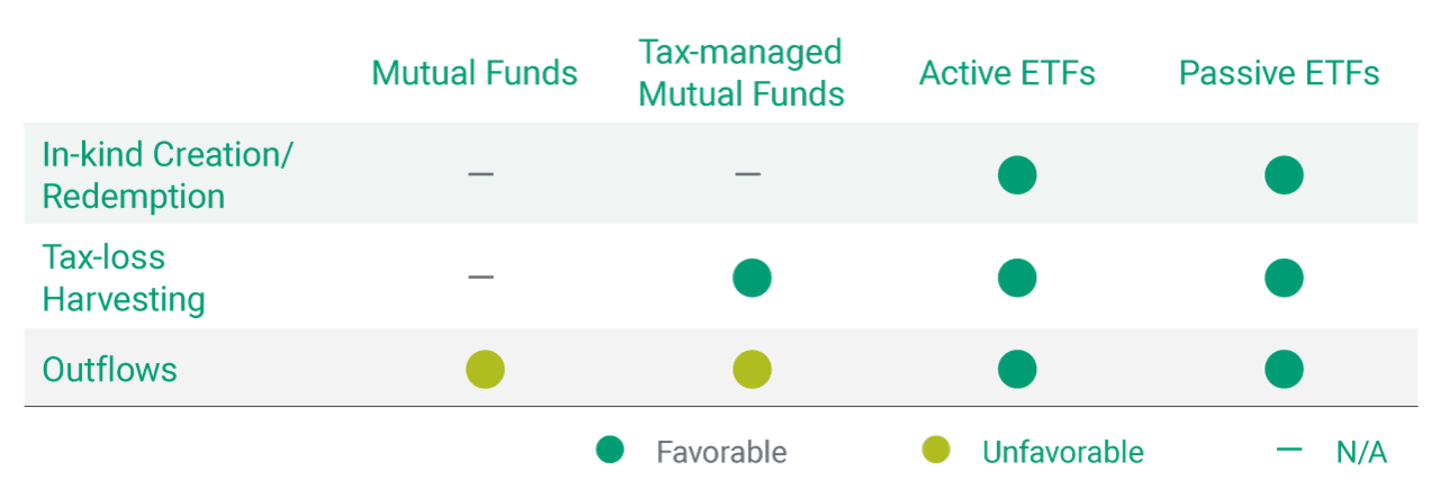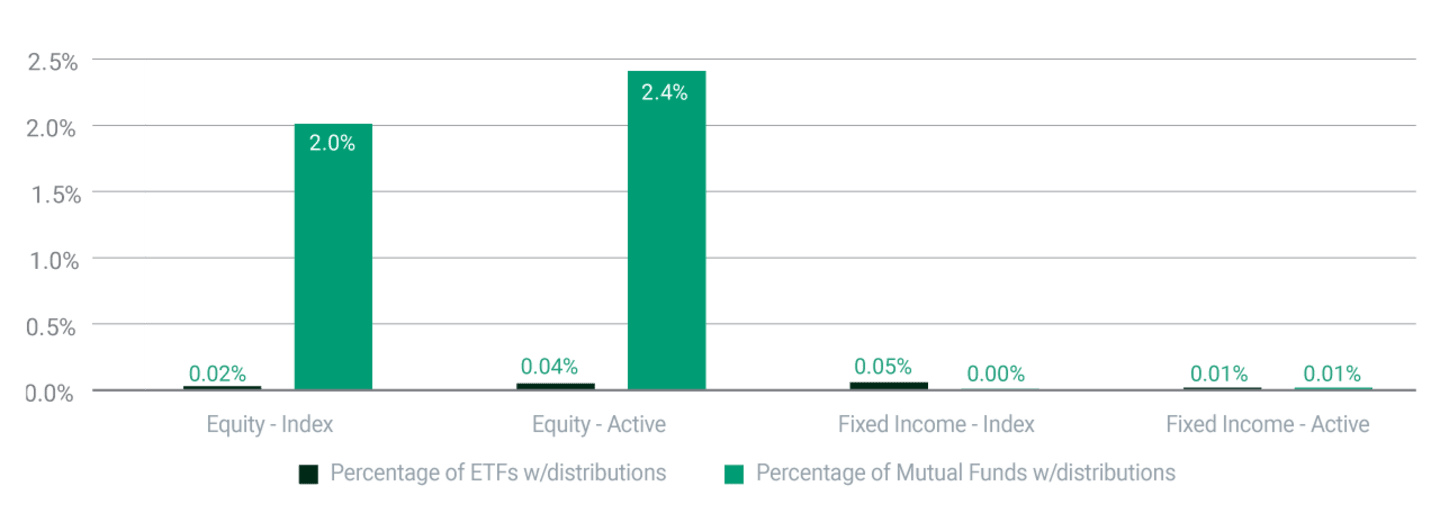Understanding the Tax Efficiency of ETFs
Having a tax-efficient portfolio is critical for investors. The results of a recent case study by American Century Investments help quantify the tax efficiency of ETFs over mutual funds for both equity and fixed-income vehicles.

Keeping an Eye on Taxes
Advisors and investors tend to look for opportunities to reduce capital gains near year-end. However, thinking about taxes all year long may create better outcomes. Opportunities to offset capital gains with capital losses, known as tax-loss harvesting, can emerge at any time. Take into consideration tax rules that need to be followed when tax-loss harvesting. Other strategies that investors may employ include capital gains avoidance and vehicle selection.
Avoiding Capital Gains
Most mutual fund and ETF providers announce on their websites their estimated annual capital gains distributions beginning in September, with a payable date typically in December.
With the potential for more taxable events, mutual funds may be more appropriate in tax-deferred accounts, such as retirement accounts. For accounts that are not tax advantaged, investors should consider ETFs over mutual funds to potentially reduce their annual tax bills.
Both mutual funds and ETFs are required to distribute capital gains and income to investors at least annually. It’s important to pay attention to these estimates as there can be instances where the capital gains distributed represent a significant amount relative to the asset value. Investors may have an opportunity to sell a fund projecting a significant capital gain prior to the record date, thereby avoiding the taxable distribution. Bear in mind, selling a position may avoid the current year distribution but itself creates a taxable event depending on the price and holding period of the investment.
Taxes on ETFs vs. Mutual Funds
Because of structural differences between mutual funds and ETFs, mutual funds generally incur more capital gains year over year, while the ETF structure minimizes capital gains until shares are sold. Generally, not only are ETFs liquid and low cost, they are also tax efficient. Deferring annual capital gains allows more of the assets to remain invested and potentially compound at a higher rate. As a result, ETFs may be the optimal vehicle for investors keen on managing their annual tax bills. Keep in mind, however, investors are also subject to capital gains tax if they earn a profit from trading their individual ETFs or mutual fund shares (i.e., selling for a higher price than they paid).
Tax Efficiency Across Investment Vehicles
American Century Investments recently analyzed the tax efficiency of various investment vehicles. We found ETFs—both active and passive—were the most tax-efficient vehicles in our study. Figure 1 outlines our findings.
Figure 1 | ETFs Have More Tools at Their Disposal

Source: American Century Investments.
Sources of Tax Efficiency
With mutual funds, flows into and out of the fund are transacted in cash. The manager often must sell portfolio securities to accommodate shareholder redemptions or reallocate assets. These sales may create capital gains for all fund shareholders, not just the ones selling their shares. These gains are taxable for all fund shareholders.
By contrast, ETF managers accommodate investment inflows and outflows through the in-kind share creation and redemption process, which enables them to shed securities that may generate significant capital gains. ETF shares are passed back and forth on the exchange without transactions occurring among the underlying securities. This creates an additional level of liquidity. Trading in kind may help eliminate or significantly reduce costs compared to trading the underlying securities. In addition, when managers rebalance an ETF portfolio, they typically apply tax management strategies, such as tax-loss harvesting, to minimize gains distributions.
Actively managed ETFs are now on the same playing field as indexed ETFs. Securities and Exchange Commission Rules 6c-11 now allow active managers to use optimized and custom or negotiated in-kind baskets for ETF creations and redemptions. The rules seek to provide more transparency to investors by requiring firms to provide historical premium, discount and bid/ ask spread information on their websites. Additionally, it will further enhance the tax efficiency of transparent and nontransparent active ETFs.
Distribution Patterns of ETFs Versus Mutual Funds
We also examined historical capital gains distributions by strategy—index and active—for equity and fixed-income portfolios. Figure 2 shows the percentage of funds distributing in each category from the inception of each fund to December 31, 2023. The percentage of equity ETFs paying capital gains was significantly lower than mutual funds in all categories. It is more challenging for portfolio managers to implement tax-loss harvesting strategies in fixed income ETFs because bonds have specific maturities, durations, seniority, and risks associated with contracts and timing. However, there were still fewer fixed-income ETFs distributing capital gains. Even for active equity ETFs, only a little over 2% paid out gains, compared with 47% of their mutual fund counterparts. Similarly, 0.3% of the active fixed-income ETFs paid capital gains, while 2% of active fixed-income mutual funds did.
Figure 2 | Funds With Distributions (%)

Source: Morningstar, Bloomberg. Data from inception of each fund to 12/31/23. Calculations derived by using the universe of mutual funds and ETFs available in Morningstar and calculating the percentage of funds and ETFs that distributed capitals gains versus those that did not.
Using the same categories, we evaluated the average capital gains distribution as a percent of the fund’s net asset value. As Figure 3 highlights, the amount that equity ETFs distributed was significantly lower than mutual fund distributions. In fact, the equity mutual fund distributions were staggeringly larger than the ETF distributions. While not as large a dispersion, the fixed-income ETFs’ distributions were slightly higher in all but the active category.
Figure 3 | Capital Gain Distributions (%)

Source: Morningstar, Bloomberg. Data from inception of each fund to 12/31/23.
An Effective Tool for Managing Taxes
Not only do ETFs offer lower cost and liquidity, they also offer tax efficiency, which can aid a portfolio’s overall performance and allow investors to keep more of what they’ve earned invested. Keeping an eye on taxes year-round can help manage the tax bite at year-end.
Do ETFs Have a Place in Your Portfolio?
ETFs can be combined with other investments, including mutual funds and individual securities, to build diversified and flexible portfolios.
Investment return and principal value of security investments will fluctuate. The value at the time of redemption may be more or less than the original cost. Past performance is no guarantee of future results.
This material has been prepared for educational purposes only. It is not intended to provide, and should not be relied upon for, investment, accounting, legal or tax advice.
IRS Circular 230 Disclosure: American Century Companies, Inc. and its affiliates do not provide tax advice. Accordingly, any discussion of U.S. tax matters contained herein (including any attachments) is not intended or written to be used, and cannot be used, in connection with the promotion, marketing or recommendation by anyone unaffiliated with American Century Companies, Inc. of any of the matters addressed herein or for the purpose of avoiding U.S. tax-related penalties.
This information is for educational purposes only and is not intended as tax advice. Please consult your tax advisor for more detailed information or for advice regarding your individual situation.
Diversification does not assure a profit nor does it protect against loss of principal.
©2026 Morningstar, Inc. All Rights Reserved. Certain information contained herein: (1) is proprietary to Morningstar and/or its content providers; (2) may not be copied or distributed; and (3) is not warranted to be accurate, complete or timely. Neither Morningstar nor its content providers are responsible for any damages or losses arising from any use of this information.